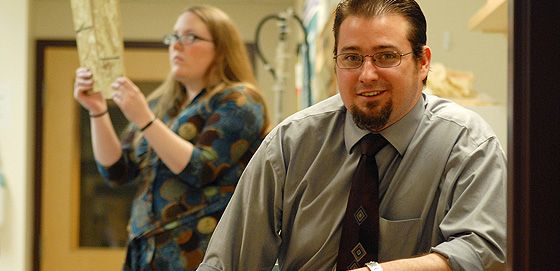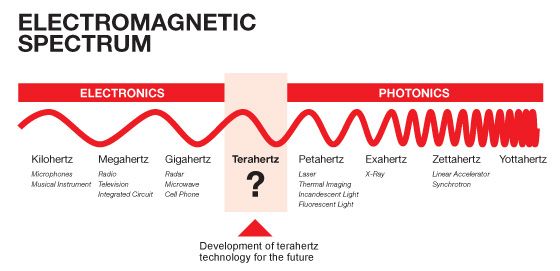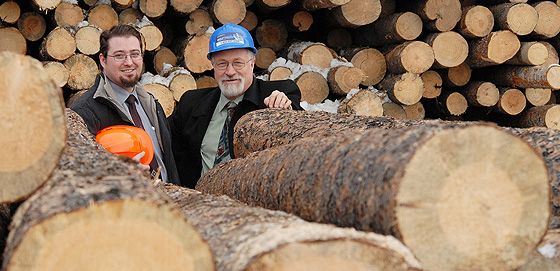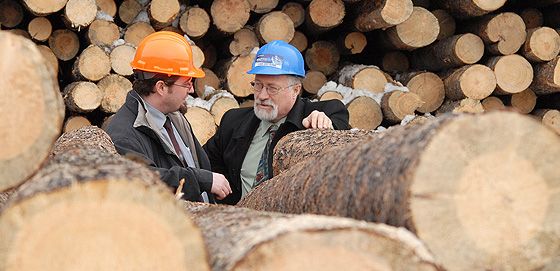Terahertz: Riding the Wave of the Future

Dr. Matt Reid in foreground with student Tara Todoruk in the background. Download high-resolution image.
"The possibilities for terahertz technology are just mind-boggling."
X-ray vision is yesterday’s news. Terahertz technology is the wave of the future. Terahertz occupies space on the electromagnetic spectrum between microwaves and x-rays and that’s where UNBC prof Matt Reid has focused his vision. He has just beaten a world record set in 1993, putting him in competition with researchers from MIT.
It was at the Advanced Laser Light Source facility in Montreal that UNBC’s Matt Reid and his fellow researchers from UNBC, Alberta, Ontario, and Quebec used ultrafast lasers to produce bursts of terahertz waves with the largest energies ever. This achievement means they can see right through objects in real time. Terahertz waves have been the subject of research for about 20 years, but Dr. Reid’s accomplishment opens up a whole new world for application of the technology.
“We’re now at the cusp of translating our knowledge into industrial application,” says Dr. Reid, a professor of Physics at UNBC. “Where we are right now with our development of terahertz technology is where other researchers were when lasers were first invented. Since then, lasers have been used in everything from industry to everyday life. The possibilities for terahertz technology are just as mind-boggling.”
That’s because terahertz waves have a unique quality. Like x-rays, terahertz signals provide opportunities to see through objects and also see features inside these objects. But unlike x-rays, they don’t pose health dangers.

Image of the electromagnetic spectrum. Download PDF document.
What are the potential applications? Airport security, identifying early-stage skin and breast cancer, and detecting pollutants in the atmosphere all come to mind. But Dr. Reid is focusing his attention on the backbone of the BC economy: the forest industry.
Working closely with UNBC Forestry professor Ian Hartley, student Tara Todoruk, and Bruce Sutherland of Prince George’s Wolftek Industries, Dr. Reid is aiming to create devices that will utilize terahertz waves to provide forest operations with the ability to see inside wood and determine the fibre quality of logs and processed wood products. The goal is to maximize the value of each tree.

Dr. Reid and Bruce Sutherland of Prince George's Wolftek Industries. Download high-resolution image.
“The more we learn through this terahertz research, the more ideas we have for how to apply this technology in the field,” says Bruce Sutherland, Wolftek President. “For the industry, the possibilities are worth millions of dollars.”
Time is of the essence, thanks to the mountain pine beetle. Forest companies are scrambling for a way to see the insides of trees so that logs can be properly positioned in the mill for maximum efficiency. Just viewing the outside of a tree is no longer good enough, as pine beetle trees often have cracks inside that can greatly affect the wood quality and potential products. Terahertz technology would essentially give mill managers x-ray vision.
“This is a terrific example of how world-class, fundamental research can have very direct application to industry and economic development,” says Dr. Reid, who graduated from D.P. Todd Secondary in Prince George, worked at a local sawmill, and was one of UNBC’s first students in 1994. “Right now, we’re leading the world and the challenge for us will be to stay at the forefront in commercializing the results of this research for the benefit of the local economy.” The BC forest industry is hoping that he’ll be successful.


Download high-resolution image.
Dr. Reid's Bio
Dr. Reid's research interests are in the area of nonlinear optics of semiconductor surfaces including optical rectification and second harmonic generation from nanostructured surfaces. This research is targeted at the optimization, characterization and applications of terahertz sources and detectors, where he works with other Canadian researchers at the Advanced Laser Light Source. In particular, Dr. Reid is interested in applications of terahertz technology to the wood products industry and works closely with his colleagues in Forestry at UNBC. He received a B.Sc. in Mathematics and Physics from UNBC is 1999, and his Ph.D. in Electrical and Computer Engineering at the University of Alberta in 2005. He has been at UNBC with the Physics program since 2005.
Matthew Reid
Assistant Professor, Physics
PhD, Electromagnetics, Department of Electrical and Computer Engineering, University of Alberta
Contact:
250.960.6622
matt.reid@unbc.ca
Additional Information:
- UNBC Physics Program
- Dr. Reid's Web Page
- Advanced Laser Light Source facility
- Wolftek Industries
Audio and Video Files
- Audio files are available of Dr. Reid discussing terahertz technology and applications in various industries.
- Broadcast-quality video footage is available.